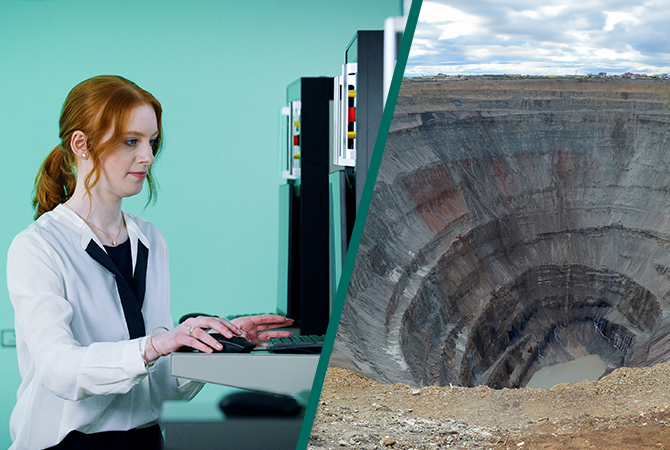All about lab-grown diamonds
The founders of Nevermined were immediately enthusiastic about the possibility of growing real diamonds in the laboratory and therefore also interested in the entire production process for lab-grown diamonds – but what are lab-grown diamonds and what are they made of? What are the correct terms in the diamond industry, what processes are used to produce them and what quality criteria do lab-grown diamonds fulfil? We answer all your questions about our diamonds.
What are lab-grown diamonds and what are they made of?
While naturally grown diamonds are formed over millions of years from carbon under high pressure and high temperature inside the Earth, lab-grown diamonds (or LGD for short) are made by human hand in the laboratory. There, in a controlled environment, diamond seeds grow to the desired size within a few weeks using highly complex technologies. The diamonds cultivated from this process have the same chemical and physical properties as mined diamonds. They are also made of 100% carbon, achieve a hardness level of 10 on the Mohs hardness scale and often even surpass their natural models in the 4C quality criteria. Since they are in no way inferior to mined gemstones (and even have some benefits by comparison), laboratory diamonds receive the same certifications as their natural counterparts from recognised institutes.
Are lab-grown diamonds real diamonds?
Yes. Lab-grown diamonds are visually, chemically and physically completely identical to mined diamonds. They are not imitations, but real diamonds. Nevermined diamonds are guaranteed to be exclusively lab-grown diamonds with characteristics 100% identical to naturally grown diamonds.
How can you tell that a diamond is lab-grown?
Whether a diamond has been grown naturally or in a laboratory is indistinguishable to the naked eye. Experts also need special tools for this. Cultivated gemstones can be identified using the unique laser engraving on the girdle, i.e. on the edge of the stone. The way the carbon was incorporated into the diamond lattice also indicates whether the stone was made in a laboratory or not. Diamonds produced in the HPHT process, for example, have a crystalline, cuboctahedral shape, while CVD diamonds are more like a disc due to the starting material. The rough diamonds extracted therefore differ in shape from natural rough diamonds. Nevermined diamonds from 0.5 carats upwards also always come with an official certificate of authenticity from one of the most recognised laboratories in the world, the GIA (Gemological Institute of America) or the IGI (International Gemological Institute).
What quality criteria do lab-grown diamonds meet?
The ‘4C’ are criteria that define the quality and value of a cut diamond. They are derived from the first letters of the criteria: Carat, Colour, Clarity and Cut. Naturally grown diamonds have always been assessed according to these criteria and receive a corresponding certificate, for instance, from GIA or IGI. Since lab-grown diamonds are physically and chemically identical to natural diamonds, they are evaluated using the same criteria. Only the note in the certificate stating that the diamonds have been grown indicates the difference.
Are lab-grown diamonds cheaper?
Lab-grown diamonds can be sold cheaper than mine diamonds – despite the same quality. There are many reasons for this. Firstly, diamond mining in open-cast or underground mines is associated with extensive mining processes, high personnel costs and complex logistics. On average, over 200 tonnes of earth have to be moved to produce a single carat of mined diamond. None of this is required for lab-grown diamonds. Moreover, diamonds from laboratory production almost always result in the highest category of clarity, which rarely occurs in nature. Just 1% of the diamonds mined are of the quality required for the jewellery industry. Meanwhile, the CVD process can provide almost all of the stones needed for exclusive jewellery under controlled conditions. This has a very positive effect on the price for end consumers. While mined diamonds often justify their high price by scarcity and rarity, at Nevermined, our aim is the exact opposite. We want to contribute to the democratisation of luxury by making genuine diamonds of the highest quality accessible to next generation customers.
Do diamonds from the laboratory also have drawbacks?
Compared to mined diamonds, lab-grown diamonds have few drawbacks. Nevertheless, we think it’s important to mention these, too: mined diamonds are still widely used as an investment product to obtain value in a very small space. This function does not (yet) apply to lab-grown diamonds. Grown diamonds also have a different history from mined diamonds. Although lab-grown diamonds have a more ethical background, for some people, there is value in the appeal of carrying something that has been shaped over millennia by nature itself. An exotic place of origin is often perceived as romantic. Mined diamonds pride themselves on being a scarce, difficult to obtain and very rare resource, which is not true of lab-grown diamonds – on the contrary. We want to consciously counteract this movement in favour of the environment.
Why are lab-grown diamonds more sustainable than mined diamonds?
Mining diamonds is associated with countless negative environmental impacts, ethical issues and economic challenges. To access natural diamonds in open-pit or underground diamond mines, tonnes of earth have to be moved, which can cause soil erosion. In contrast, to make lab-grown diamonds, no rainforests need to be cleared, no arable land must be rendered unusable, and no water resources are polluted. Lab-grown diamonds from Nevermined also produce lower amounts of CO2 in both their creation and transport, leaving a smaller carbon footprint. They are entirely free of inhumane working conditions or social conflict. In short: the production of diamonds in a laboratory can avoid almost all the negative impacts of mined diamonds without losing quality or increasing the price.


Laboratory diamond vs mine diamond
The diamond industry has faced serious challenges for many decades. Mining diamonds was and still is associated with social and ethical conflicts and serious environmental impacts. By producing diamonds in the laboratory, we at Nevermined can avoid all the conflicts associated with mining diamonds.
